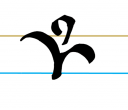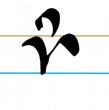Tionscadal na Nod
ut (v and 9-like symbol)
Image:
1.

2.

1.
Source: Dublin, Royal Irish Academy, MS D ii 1 (1225) = Leabhar Uí Mhaine (The Book of Uí Maine) [1394], f. 122vbFile:
2.
Source: Oxford, Bodleian Library, MS Rawlinson B 512 [s. xv–xviin], f. 12vbFile:
Letters displayed:
<v>
Base form in image, without marks, as it may appear to the untrained eye.
Represents in Latin:
ut
In the scribe’s mind or in normalised spelling.
Appearance
Build type:
Combination
Notational device:
Superscript symbol
Components:
In superscript:
Symbol(s):
apostrophe (superscript)
Represents: □s, □()s (Irish)□us, □()s, □() (Latin)
At the baseline:
Alphabetic letters:
u (v-shaped)
Represents: u (Irish)u, v (Latin)
Notational device: Allograph Allograph of: u (regular letter)Meaning
Represents:
In Latin: ut
Context
Comments:
In early insular Latin writing, a more common form for ut is a u with a suspension stroke over it. Lindsay states that this form “survived in the Bobbio scriptorium till about the middle of the eighth century. But for the rest of our period [until c. 850] ‘ut’ is symbolised perhaps only by Welsh and Cornish scribes. They write it as u (usually in the v-form) with a comma or dot above which in time (after 850) finds its way into Irish and Anglosaxon script too [...]”.(1)n. 1 W. M. Lindsay, Notae Latinae: an account of abbreviation in Latin mss. of the early minuscule period, c. 700-850 (1915): 320–321.




